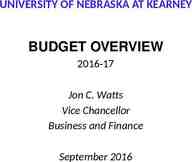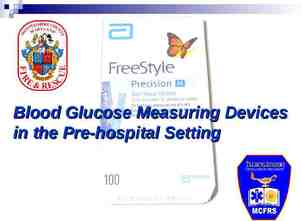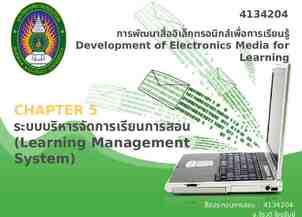STRATEGIC SCHOOL PLANNING: DEEP PLANNING PHASE 2018-19 School Year 1
31 Slides6.03 MB

STRATEGIC SCHOOL PLANNING: DEEP PLANNING PHASE 2018-19 School Year 1

DENVER PLAN 2 0 2 0 Vi s i o n : Every Child Succeeds GOAL #1 Great Schools in Every Neighborhood GOAL #2 GOAL #3 A Foundation for Success in School Ready for College and Career GOAL #4 GOAL #5 Support for the Whole Child Close the Opportunity Gap 2

INSTRUCTIONAL IMPROVEMENT 2018-19 School Year PRIORITIES In order to accelerate our progress toward the Denver Plan 2020 goals, and prioritize central office supports, we will focus on four specific high leverage strategies: 1. Early Literacy 2. Culturally Responsive Education (CRE) 3. Coaching and Leadership in service of best first instruction 4. Building College and Career Readiness for all students by Redesigning the Secondary School Experience 3

The Instructional Improvement Priorities have evolved to continue improving the work, but the broad topics have remained DP 2020 consistent. Introduced 2014-15 2015-16 2016-17 2017-18 2018-19 TLC Coaching & Leadership in Service of Best 1st Instruction Coaching & Leadership in Service of Best 1st Instruction Teaching Leading Culture Invest Early Early Literacy Flexibility ELD OTG Early Literacy/BFI Redesigning the HS Experience CCR for all students CRE 4

1. EARLY LITERACY Given the importance of reading at grade level by the end of third grade, we will continue our multi-year focus on early literacy. In the 2018-19 school year, we will prioritize multi-tiered supports by maintaining the focus on best first instruction while enhancing support to schools for our struggling readers through interventions so that school staff can strategically target at-risk students. Implications for Schools: To ensure Early Literacy Specialists are set up for success in the coming year, please identify them by May 1 (link to guidance) and build their work into your school plans. In order to ensure students are on track to read at grade level by the end of third grade, be sure to implement the shifts required for students to meet the aimlines (additional information and resources coming this summer). C&I has created several examples illustrating how to incorporate a variety of early literacy strategies into your UIP (link to resources). Schools that score Red on any literacy measure on the DPS SPF (READ Act or CMAS) should review these examples for additional ideas on how to improve practices when updating their UIP.* If you are considering shifts in the curriculum and/or assessment you selected, please consult with your Literacy and ELA partners before *highly recommended for all schools 5

2. CULTURALLY RESPONSIVE EDUCATION In an effort to eliminate persistent academic and opportunity gaps, we will continue to focus on shifting mindsets and practices and expanding best practices identified through pilots, with an eye towards a systems-level evaluation of cultural responsiveness and equity of opportunity in 2019-20. Implications for Schools: To address areas of disproportionality, schools in the Opportunity Gap Cohort will address equity in their UIP Major Improvement Strategies (link to guidance). The guidance provided to Opportunity Gap Cohort schools is available as a resource when developing UIP data narrative and action steps. The Framework of Culturally Responsive Teaching will be available shortly as a resource for teachers. Please review it with your ILT and identify opportunities for growth. 6

3. COACHING & LEADERSHIP IN SERVICE OF BEST FIRST INSTRUCTION Coaching & Leadership are the work of individuals and the collective as an ILT, in service of moving the school as an organization. Best First Instruction is culturally responsive, data-driven teaching and learning that provides all students with joyful, rigorous, and personalized learning scaffolded to meet learners where they are and accelerate them to grade-level and beyond. The Instructional Leadership Team is a group of school-based leaders who establish and maintain instructional systems in service of increasing student achievement and improving teacher effectiveness. Therefore, if you don’t have strong talent and systems for your ILT, your best-in-class Strategic School Plan won’t be transformative for your students! Implications for Schools: Consider how your role as Principal and Leader of Leaders can manifest during the planning process. Use the process and deep conversations of 7 planning to launch a strong ILT for the 18-19 year that is grounded in shared goals.

4. BUILDING COLLEGE & CAREER READINESS FOR ALL STUDENTS PRIORITIES In order to ensure all students graduate college and career ready, we will prioritize supporting schools with the following actions in the 2018-19 school year: Identifying content standards knowledge and instructional practices that literacy and math teachers need to ensure a joyful, rigorous and personalized approach to instruction that matches the rigor of the standards, K-12, with an explicit focus on secondary math. Providing multiple opportunities and targeted supports to ensure students are able to demonstrate college and career competency and take advantage of post-secondary learning opportunities. Continue to expand access and enrollment in AP, CE, IB, and/or CTE courses, with a focus on equity for all students Continue to implement the ACCUPLACER Strategy to ensure that students have access to rigorous, college-level courses Continue to build out the CareerConnect and expand Early College Model and the CareerResidency Youth Apprenticeship, with a focus on certificates and/or college credits up to and including associate degrees Ensuring targeted and coordinated supports for students in transition grades (5th, 6th, 8th, and 9th grade) through advising, summer 8 programming, and increased interventions.

4. BUILDING COLLEGE & CAREER READINESS FOR ALL STUDENTS CONT. Implications for Schools: Conduct data team meetings in math at least every other week to monitor student progress toward standards mastery, to target gaps, and to identify shifts in instructional practices. Identify a team member who will lead and facilitate your mathematics teachers in reviewing data to identify shifts in instructional practices needed and build content standards knowledge. If your school opted into district curriculum and PD in a core content area, ensure your teachers attend corresponding PD ( Summer PD dates). Identify multiple approaches to prepare students for the PSAT and SAT (e.g., embedded in curriculum, practice tests, Khan Academy, daily practice questions, etc.). Ensure supports are in place for transition grades (5, 6, 8, and 9) through summer programming, advising, and increased interventions. Provide dedicated and coordinated supports for math intervention 9to students (link to guidance).

4. BUILDING COLLEGE & CAREER READINESS FOR ALL STUDENTS CONT. Implications for Schools cont.: Ensure all students in grades 9-12 have access to AP, CE, IB, and/or CTE courses. Provide counseling and advising to every student in grades 6-12 in order to increase college and career opportunities. In addition, ICAPs should be completed by every student at the end of each quarter. Accuplacer Strategy: Demonstrating competency and expanding access to college courses - Non-Early Colleges: Test all 11th & 12th graders (in fall and spring) who have not already demonstrated competency in Math and/or English. - Early Colleges: Ensure all 9th graders have access to supports needed to pass Accuplacer and enroll in college courses (e.g., Accuplacer advisory course); support and test all 9-12th grade students who have not already demonstrated competency in Math and English. - Plan for expansion and access to CareerConnect pathways that are aligned with high-opportunity Colorado industries and link to a wide array of postsecondary education opportunities, including two and four-year degrees, industry credentials, and CareerResidency youth apprenticeships. Approved Early College High Schools should continue working toward their implementation targets in coordination with the early college implementation team. 10

Strategic School Planning Strategic School Planning (SSP) is the means by which schools align the Instructional Improvement Priorities of the district to their individual context. When reviewing the following guidelines for Strategic School Planning, be sure to consider the relationship with the preceding Instructional Improvement Priorities of the district, the expectations for your ILT, and the LEAD Competencies for School Leaders.

VISION FOR STRATEGIC SCHOOL PLANNING The strategic planning process helps schools define their strategies for achieving student success. Robust and authentic Strategic School Planning will combine a focus on quality execution, regular progress monitoring of both adults and students, and continuous improvement to increase school capacity and accelerate student growth towards the Denver Plan 2020 Goals. 12

STRATEGIC SCHOOL PLANNING Annual Cycles Nov. – Feb. Pre-Planning Aug. – May Mar. – July Deep-Planning Implementation & Monitoring Additional Inputs Budget & Staffing PrePlanning Budget, Staffing, and Flexibility Decisions Flexibility Evaluation Using the priorities and inputs, Develop the UIP and the Outputs of School Structures & Systems (including definitive action steps) Implement Strategic School Plan Continuous Evaluation and Adjustment of Plan UIP Submission June This year’s Continuous Improvement Cycle informs next year’s planning Pre-Planning Deep-Planning Implementation & Monitoring 13

STRATEGIC SCHOOL PLANNING Annual Cycle – Detailed View Phases Foundational Components School’s Mission and Vision District Priorities (to be released December. 2017) UIP (Major Improvement Strategies) Accountability (SPF, LEAP, LEAD, SLOs) Pre- Planning (Nov. – Feb.) Understand needs and define priorities for the upcoming school year. “The What” Deep Planning (March – July) Develop detailed granular plans “The How” * Required Outputs Input: Enrollment & Budget Proj’s Data CCR Targets Parent/Community input SPF Planning Tool (projected / real) Root Cause or Needs Analysis Input: CIG Monitoring and timely data analysis ILT Reflection & Calibration Annual UIP Handbook District Master School Yr Planning Calendar LEAP & LEAD data School Design Plan SPF Planning Tool (projected / real) Curriculum Adoption Timeline District Professional Dev. Calendar Quality Questions: Quality Questions: What modifications do you need to make to your MIS or action steps to address root causes and/or data (e.g. SPF, interim progress, etc.)? How will the use of staff, resources, budget, enable the implementation of your strategy? Consider additional questions from the Step-Back Guide. How will your school systems and structures need to be created to support the implementation of the strategy? What have you learned in the previous year that you want to consider for this year? What are the leadership moves you need to take as a result of what you learned over the course of the year? Implementation & Monitoring (Current year Aug. – May) Create smart, short term cycles of action, assessment & adjustment Input: Timely data analysis CIG Conversations Previous 90-Day Plans (if applicable) Progress Monitoring, Short Action cycles School Structures & Systems from Deep-Planning Quality Questions: How will the school identify if the plan(s) is ‘on-track’ for both students and adults? How will you know if your school systems and structures need to be modified to support the implementation of your strategy? What actions will be monitored for this year? Essential Outputs: Essential Outputs: Flexibility Decisions * TLC Plan (TLC Tool) * Staffing Plan * Budget (Budget Form) * Blueprint for Master Schedule UIP (Strategies, Action Plans, & Benchmarks) * School Structures & Systems ‐ Professional Development Plan * ‐ DDI Plan (Assessment Strategy, Weekly Data Meetings, etc.) * ‐ Obs/Feedback Plan * ‐ Master Schedule and School Calendar * ‐ Culture Plan (Staff & Student) ‐ Monthly Map ‐ Lesson Plan System Foundational Components Essential Outputs: UIP / CIG Progress Monitoring (4-6 week cycles) * 90 Day Plan(s) (if applicable) Adjusted School Structures14 & Systems (as needed)

DEEP PLANNING: ESSENTIAL OUTPUTS UIP and School Systems & Structures To promote best practice for school planning and meet state requirements, Unified Improvement Plans (UIPs) are required for all schools, including Strategies, Action Plans, and Implementation Benchmarks. To promote best practice, in alignment with LEAD competencies, the following School Systems & Structures are required*: - Professional Development Plan School leaders may elect to - Data Driven Instruction (DDI) Plan create one plan that integrates - Observation & Feedback Plan strategies. - Early Literacy Plan (addressed in your UIP if you score Red onthese any literacy measure on the DPS SPF) - Master Schedule & School Calendar Schools in the Elementary Division should upload all completed files here; Schools in the Secondary Division here. *Each of these outputs are required if they are not explicitly embedded in your UIP as a school-wide major improvement strategy. If the outputs are not embedded in your UIP, templates and example plans will be made available for reference. 15

DEEP PLANNING: HOW THE ESSENTIAL OUTPUTS COME TOGETHER WITH YOUR ILT 16

PROFESSIONAL DEVELOPMENT PLAN* Deep Planning: Best Practices Best practices to consider when crafting your PD Plan: - Identify year-long objectives for adult learning, supported by your analysis of student outcomes. Be sure to include plans for leaders of leaders. - Identify areas of alignment between your PD strategy and the Denver 2020 Plan, DPS Instructional Priorities, and school UIP. - Clearly articulate the roles of those planning and delivering PD, including members of your ILT and network partners, and ensure they are adequately prepared to deliver the PD. - Identify your schedule for the year, including how you will use PD days in August, as well as other Teal Days. - Align plan with UIP Major Improvement Strategies & Implementation Benchmarks and DDI and Observation/Feedback Plans, including follow up coaching . 17 *required only if it is not explicitly embedded in your UIP as a school-wide major improvement

DATA DRIVEN INSTRUCTION (DDI) Deep Planning: Best Practices PLAN* In order to effectively monitor student mastery of grade level standards, reflect on prior instruction, and identify instructional shifts needed, be sure to. - Administer at least three medium-scale assessments in literacy and math throughout the year (e.g., unit assessments loaded into Illuminate) to determine how well students have mastered the standards, then identify opportunities to address misconceptions in upcoming lessons. and consider the following best practices - - Implementing sound formative assessment practices to frequently monitor student progress in relation to grade level skills and standards and adjust instruction in real time (e.g., quizzes, exit tickets). ELD progress monitoring strategies (see next two slides) Structured protocol for conducting data team meetings for math and literacy, at least every other week, that includes unpacking standards and exemplars, reviewing student work, naming the conceptual understanding needed to close gaps, and identifying specific next steps for instruction Backwards planning, including individual lesson plans, based on unit 18 objectives and standards maps. *required only if it is not explicitly embedded in your UIP as a school-wide major

ELD PROGRESS MONITORING Slide 1 of 2 Best Practice: Teachers use the DDI process to evaluate students’ language proficiency and adjust instruction in order to accelerate students’ language development, utilizing a variety of assessments (see next slide). Students’ language data should be included and prioritized in the school’s larger DDI and CIG cycles. 1. Planning for language in Dedicated ELD and content areas - Dedicated ELD: Language objectives are designed and differentiated by students’ language proficiency level. - Content Areas: Content-language objectives identify the content students will learn and the language students will need to be successful with the content. Supports for both content and language are differentiated by student data. 2. Collect and score students’ work samples - Student work samples can come from formative or interim assessments, taken from ELD and content areas (see below*) - Utilize Scoring Protocol when using WIDA rubric 3. Analyze student work samples for language in DDI cycles - Utilize the ELD DDI Protocol with WIDA or curricular specific rubrics 4. Refine language instruction - Using feedback from DDI conversations, refine language instruction in ELD and content areas to effectively drive rigorous, targeted language instruction for 19 English Learners

ELD PROGRESS MONITORING Slide 2 of 2 Elementary Assessment Recommendations: Formative Assessment (evidence of learning while instruction is underway): Daily, weekly, and unit assessments Interim Assessment (how well students are meeting medium term goals): SBRC, SLOs (writing/speaking prompts scored with WIDA Interpretive Rubric) Summative Assessment (language proficiency level growth): WIDA ACCESS Secondary Assessment Recommendations: Formative Assessment: Daily and weekly assessments Interim Assessment: Secondary PBTs and leveled writing and speaking prompts aligned to SLOs (available for grades 612 on Schoology); recommended that one prompt be administered at the end of each quarter to guide instruction for the following quarter. Summative Assessment: WIDA ACCESS 20

OBSERVATION & FEEDBACK PLAN* Deep Planning: Best Practices Best practices to consider when crafting your Observation/Feedback Plan: - Alignment with UIP Major Improvement Strategies, Professional Development Plan, and DDI Plan - Schedule/cycles for the school year** - The roles and responsibilities of members of your ILT and network partners. This includes your plans for developing your Teacher Leaders (e.g., providing feedback on the Obs/Feedback sessions they conduct for teachers) - Structured protocol for preparing, observing, providing feedback, and identifying and tracking action steps. - Utilize Whetstone to track and communicate observations and feedback, including action steps. *required only if it is not explicitly embedded in your UIP as a school-wide major improvement strategy **Note: LEAP requires at least one full and one partial observation, with the results from at least one observation entered in the system prior to midyear conversations 21

EARLY LITERACY PLAN* Deep Planning: Best Practices C&I has created several examples (for TNLI schools, non-TNLI schools, schools with academic gaps, and schools with a lack of alignment between Istation and CMAS scores) that illustrate how to incorporate a variety of early literacy strategies into your UIP (link to resources). Schools that score Red on any literacy measure on the DPS SPF should review these examples for additional ideas on how to improve practices when updating their UIP.* This is highly recommended for all other schools. Best practices to consider when crafting an Early Literacy Plan: - Alignment with Summer PD (for teachers, ELS and school leaders) Use of allocation of Mill Levy funds to support your priorities Relationship with Professional Development plan Relationship with DDI plan Relationship with Observation/Feedback plan *required only for schools that score Red on a literacy measure on their SPF. 22

MASTER SCHEDULE & SCHOOL CALENDAR Deep Planning: Best Practices Your Master Schedule and School Calendar play a critical role in maximizing learning for all students and enhancing collaboration among staff. When developing your Master Schedule and School Calendar, be sure to also consider the following: How best to structure your master schedule to support the priorities identified in your Unified Improvement Plan (UIP). District academic content area guidelines outlining best practice for the amount of time that should be devoted to literacy, math, science, social studies, ELD, physical education, and the arts. The expansion of post-secondary course offerings and college/career readiness experiences for students. The importance of dedicated time for math interventions to ensure all students are meeting grade level expectations. Scheduling needs for ELLs and special education students. Where your innovation plan may allow additional flexibility. Additional time needed for data meetings, observation/feedback and coaching. How to maximize collaborative planning time. 23 Use of district PD days and staff time. Most effective use of TEAL days to facilitate adult learning.

MASTER SCHEDULE & SCHOOL CALENDAR Deep Planning: Requirements In addition to best practices, all schools need to ensure the following have been addressed before finalizing their Master Schedule & School Calendar: State regulations: minimum pupil/teacher contact time and nutrition services requirements Denver Classroom Teacher Association Contract Requirements: minimums for non-student contact time, planning and collaborative time, and lunch ( link to specific guidance) DPS requirements for minimum work days for certificated staff ( link to specific guidance) Specifics related to communicating school calendars: Please use this link (google doc) to share back to school nights, family conference dates, and when you host your weekly ILT meeting. If your school calendar will deviate from the district calendar, please use the district calendar file on the commons and modify it to reflect the calendar for your school. Please post the file on your website and email it to: - Rosa [email protected] (all EED schools) - Lauren [email protected] (all DSE schools) 24

RESOURCES & SUPPORTS Strategic School Planning AVAILABLE Support and coaching from ISs, Network Partners, and Partners from Academic Departments (e.g., C&I, SEO, ELA, ARE, etc.) Strategic School Planning (SSP) website on the Commons Includes annual cycle, planning templates, examples, and additional resources Tailored and responsive supports for Intensive-Tiered Schools Use this link to view services prioritized by departments DDI Resource website Includes definitions, resources, protocols, and relevant links SLO Resources Includes background information, resources, and model SLOs LEAD Development Guide Suite of learning opportunities, job-embedded experiences, and resources that support the development of competencies outlined in the LEAD School Leadership Framework Teacher Leadership & Collaboration – Yearlong Scope & Sequence UIP Resources Includes UIP Handbook, Timelines, and Link to CDE Online Tool 25

Key Dates & Upcoming Events

STRATEGIC SCHOOL PLANNING Key Dates Mid-April Expectations Released: Includes 2018-19 Instructional Improvement Priorities & Expectations for Deep Planning Early May School Planning Templates Released: Optional templates (e.g., DDI Plan) and examples are available to assist with school planning. June 15th Draft Plans Due: Schools submit drafted Deep-Planning outputs to IS for initial review July 20th Feedback Provided: IS reviews all Deep-Planning outputs and provides feedback to schools August 10th Deep Planning Outputs Finalized: Deep Planning outputs are finalized for the start of the school year 27

STRATEGIC SCHOOL PLANNING Other Events to Consider Deep-Planning Key Dates April 15, 2018 Release of Professional Learning available for Teal Days June 5 – 8, 2018 June 8, 2018 June Leadership Week (finalize UIP and draft the Deep-Planning outputs) Internal Submission of drafted UIP for all schools June 15, 2018 Drafts due to IS for all SSP Deep-Planning outputs July 2018 UIP Feedback provided to all schools July 20, 2018 July 23, 2018 IS provides feedback to schools on SSP Deep-Planning documents July Universal Date July 23 – 26, 2018 July Leadership Week (ability to finalize Deep-Planning outputs) August 10, 2018 All SSP Deep-Planning required outputs due August 14, 2018 Central Professional Learning Teal Day August 16, 2018 Our DPS Day – Two Hour Virtual Broadcast August 20. 2018 First Day of School 28

Appendix

MULTI-YEAR SSP INCLUDES MANY COMPONENTS School Mission & Vision 5 year Improvement Goals (UIP – Major Improvement Strategies) 2 year School Structures & Systems Instruction: eg: DDI, Lesson Planning Expectations, Instructional Strategies, OTG Plan, Culturally Responsive Practice, ELA plan, Optin/Opt-out plans This year School Structures. eg: Budget, Master Schedule, Culture Plan, Community Engagement Plan Talent: eg: 0rg structure, ILT, Observation/feedback plan, PD Plans, New Teacher Support Plan Implementation and Progress Monitoring (eg, Action Plans, Monthly Map, CIG Visits) Short Action Cycles (4-6 weeks, 90 days, etc.) 30

DISTRICT CALENDAR APPROVED FOR 2018Key 19 things to be aware of The DPS Board of Education approved the 2018-19 School Calendar on Thursday, December 21, 2017 Classes for most DPS schools start Aug. 20. Classes for most DPS schools end May 31. Students and educators at most DPS schools are off for full weeks at Thanksgiving, Winter Break and Spring Break. Parent-teacher conferences have been renamed family conferences to reflect the diversity of our students’ home situations. While this calendar applies to most DPS schools, some schools — district-run, including innovation, and charter — may have slightly different schedules. The district calendar is available in multiple languages at this website. 31






